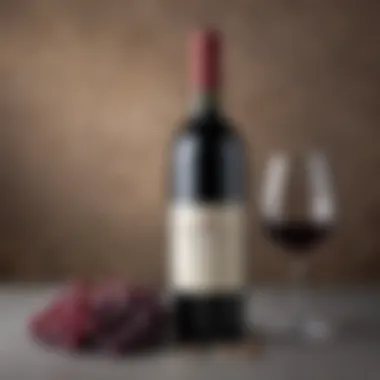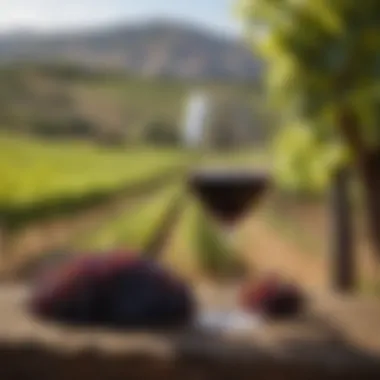Characteristics of Cabernet Sauvignon: A Dry Wine Analysis


Intro
Cabernet Sauvignon has a reputation that often precedes it—an esteemed varietal known for its bold flavors and rich tannins. The question looms large for many wine enthusiasts and casual drinkers alike: is this wine truly dry? Wine dryness often points to a reduction in residual sugar, that sweeter element many enjoy in their blends and whites. However, the discussion around dryness is nuanced, entwining the very nature of the grape, the methods used in its production, and even the very perceptions bottle by bottle.
The exploration of Cabernet Sauvignon serves as both a sensory journey and a technical inquiry. By peering into its genetic makeup, understanding the impact of terroir, and dissecting the winemaking process, one can better appreciate why this wine commands such an admirable spot on menus around the globe.
We'll explore whether the characteristics inherent to Cabernet Sauvignon lead to a consensus on its dryness or if personal taste and regional influences can sway opinions. Each section of this article aims to gradually unveil the layers that enshroud this beloved grape, all while inviting readers to consider the wider implications of what it means to classify a wine as dry.
"The terms 'dry' and 'sweet' are often unclear and subjective when it comes to wine."
Join us as we uncork the complexities and dive into the beverage world's intricate tapestry, shedding light on Cabernet Sauvignon's true essence in terms of dryness.
Prelude to Cabernet Sauvignon
Cabernet Sauvignon is often hailed as the king of red wines, possessing an allure that captivates both connoisseurs and casual drinkers alike. Understanding its nature goes beyond just tasting; it invites one to explore its historical roots, its position in today's wine market, and the flavors that underscore its popularity. In this article, we will dissect the intricacies of this varietal, particularly whether it truly deserves to be labeled as a dry wine. Whether you're a wine enthusiast or merely looking to refine your palate, grasping the essentials of Cabernet Sauvignon can greatly enhance your wine experience.
Historical Background of the Grape
The journey of Cabernet Sauvignon is nothing short of fascinating. Originally thought to have emerged in the Bordeaux region of France during the 17th century, this grape has evolved substantially over the centuries. By crossing the red grape Cabernet Franc with the white grape Sauvignon Blanc, winemakers accidentally crafted a robust varietal that could stand the test of time. Over the decades, it became synonymous with richness and depth, making its mark in vineyards across the globe. The grape's thick skin serves not only as a natural defense against pests but also aids in the development of complex flavors as it ripens under the sun.
Today, many wine aficionados trace Cabernet Sauvignon's lineage back to ancient origins, noticing how its distinct characteristics rich with black currant, cedar, and green bell pepper continue to intrigue palates worldwide. Whether in Bordeaux or California, the evolution of this grape reflects broader trends in viticulture and consumer tastes; it's history woven into every bottle.
Popularity and Global Distribution
Cabernet Sauvignon enjoys a global reputation, and rightly so. As one of the most widely planted grape varieties in the world, it flourishes in diverse climates and soils. From the valleys of Napa to the Médoc region of Bordeaux, its distribution is a testament to its versatility.
- Napa Valley is often the point of reference for luxury Cabernet. The warm days and cool nights create an environment where the grape can reach its full potential, consistently delivering wines that are both powerful and nuanced.
- Bordeaux, on the other hand, emphasizes a blend of grapes. Cabernet Sauvignon often forms the backbone of iconic merges that speak to the grandeur of French winemaking traditions.
- Australia, with regions like Coonawarra and Margaret River, brings its unique twist, often emphasizing fruit-forward styles that cater to a different palate.
The love for Cabernet Sauvignon hasn't just flourished in the vineyards, but also in wine bars and restaurants, with its presence felt globally. Tens of thousands of bottles are shipped every year, showcasing diverse flavors that reflect the terroir in which they are grown.
"To understand Cabernet Sauvignon is to understand its journey — from the ancient vineyards of Bordeaux to the modern wineries in California and beyond. Its story is a rich tapestry of culture, taste, and tradition."
In essence, recognizing the characteristics and history of Cabernet Sauvignon allows wine lovers to delve deeper into what makes this varietal special. By knowing where it originates and how it evolved, one can better appreciate the nuances that make every sip an experience.
Defining Dry Wines
Understanding dry wines is crucial in comprehending the essence of Cabernet Sauvignon. This red wine, known for its boldness and complexity, often finds itself in debates about dryness. Here, we’ll take a closer look at key factors that define dry wines and why knowing this can shape your wine-drinking experience.
The Science of Wine Sweetness
Wine sweetness is primarily determined by the amount of residual sugar left after fermentation. When yeast consumes the sugars in grape juice, it converts them into alcohol. In dry wines, this fermentation process is allowed to run its course, minimizing leftover sugar.
Key Factors Affecting Sweetness:
- Grape Type: Different grapes naturally have varying sugar levels. Cabernet Sauvignon, typically low in sugars, usually results in a drier wine.
- Yeast Strain: Choices in yeast can influence fermentation efficiency and residual sugar levels.
- Fermentation Conditions: Temperature and time can modify how completely the sugars transform into alcohol, impacting the final sweetness.
In the case of Cabernet Sauvignon, the grape’s thicker skins carry tannins and flavor compounds, often balancing out the dryness creating a full-bodied wine that feels richer, even without sweetness.
Measuring Residual Sugar in Wines
Quantifying the sweetness in wine usually involves measuring residual sugar content. This measurement helps separate dry wines from sweet ones and sets a foundation for both connoisseurs and casual drinkers.


Tools and Techniques:
- Brix Measurement: Using a refractometer or hydrometer, winemakers assess sugar levels in grape juice, translating those numbers into potential alcohol content.
- Chemical Analysis: Labs can conduct precise analyses to determine residual sugar, which might surprise drinkers as they pick up on nuanced tastes among different varietals.
- Taste Test: Often, the best way to gauge sweetness lies in tasting. The interaction of flavors, acidity, and tannins can give a false sense of sweetness even in wines labeled as dry.
Important Note:
Remember, labeling can be misleading. Not all wines labeled "dry" are devoid of sweetness; they simply lack significant residual sugar compared to sweeter counterparts.
By delving into these aspects, one gains a layered understanding of not just what makes a wine dry, but more importantly, how that plays into the appreciation of Cabernet Sauvignon. Understanding these definitions will certainly open the doors to enriching your wine journey.
Cabernet Sauvignon Flavor Profile
Understanding the flavor profile of Cabernet Sauvignon is essential to appreciating this grape varietal fully. Its complexity is a significant feature that can both intrigue and confuse wine lovers. The range of flavors varies widely depending on the terroi, winemaking practices, and age of the wine. For the reader, knowing these nuances can dramatically enhance the tasting experience, providing insights into what to expect in different bottles.
When discussing Cabernet Sauvignon, it's crucial to delve into the primary tasting notes and how aging influences these flavors. Both these elements shape not just the wine’s characteristics but also inform the pairing decisions with food, as certain flavors in the wine can match or contrast beautifully with various dishes.
Primary Tasting Notes
Cabernet Sauvignon is known for its robust and bold flavors. On the tongue, it often brings forth a medley of tasting notes that include:
- Black currant: This is arguably the defining flavor, lending a deep, fruity character that’s often accompanied by its relatives like blackberry and blueberries.
- Vegetative notes: Some wines exhibit hints of bell pepper or green olives, showcasing a herbal nuance that balances the fruitiness.
- Chocolate and tobacco: Age can introduce these richer notes, contributing to the wine's complexity.
- Spice: You might also detect traces of baking spices such as clove or cinnamon, weaving through the fruit layers.
These tasting notes combine in unique ways depending on factors like the region where the grapes are grown—whether it's the sun-baked vineyards of Napa Valley or the cooler climates of Bordeaux. Variations truly run the gamut, making each bottle an exciting exploration.
How Aging Affects Flavor
Aging plays a significant role in developing the flavor profile of Cabernet Sauvignon. Freshly bottled wine often shows a vibrant fruit character that can evolve dramatically with time. Here’s how the aging process affects the flavor:
- Tannins Softening: With age, the tannins become less aggressive. This results in a smoother mouthfeel, making the wine more palatable without sacrificing its body.
- Integration of Flavors: As the wine matures, the primary flavors merge into a harmonious blend. Fruitiness may take a backseat to more complex aromas like leather, cedar, and earthiness.
- Oak Influence: If oak barrels are involved, they gradually impart flavors of vanilla, toast, or even coffee as the wine breathes during aging. This interaction with the wood can elevate the wine, making it more multi-dimensional.
It’s not uncommon for wine enthusiasts to notice that certain vintages may evolve well into decades, moving from bold fruitiness to sublime earthier characteristics that tell a story of its time in the bottle.
"The journey of Cabernet Sauvignon from grape to glass is a fascinating narrative of time, terroir, and technique. Understand it well, and you will savor each glass more profoundly."
The flavor profile of Cabernet Sauvignon is truly remarkable and deserves a careful exploration. This knowledge enriches the overall wine experience, arms you with the understanding of what defines great Cabernet and positions you to pair it thoughtfully with food.
The Winemaking Process
The winemaking process plays a pivotal role in the narrative of Cabernet Sauvignon. It’s not just about putting grapes in a bottle; it’s a complex dance of tradition, science, and art that defines the character of the wine. Understanding this process gives us insight into how Cabernet Sauvignon can be classified as a dry wine, as several stages significantly influence the final product, including flavor, aroma, and yes, dryness.
Harvesting and Fermentation Techniques
The journey begins in the vineyard, where timing is everything. Grapes are typically harvested when they reach optimal ripeness, which varies depending on regional climate and desired flavor profiles. In warmer regions like California, grapes may be harvested when they are fully ripe, resulting in robust flavors and higher sugar content. On the flip side, cooler climates, like Bordeaux, may yield grapes that are less sweet, contributing to a different style of Cabernet Sauvignon.
The method of picking the grapes also plays an important part. Some winemakers prefer handpicking to ensure that only the best grapes make it into the fermentation process. Others might opt for mechanical harvesters, which can be more efficient and cost-effective but may also take some of the gentleness out of the process.
Once harvested, the grapes go through fermentation, where yeast transforms the sugars into alcohol. Fermentation techniques vary, with some winemakers choosing to ferment in open-top containers. This practice allows for gentle extraction of color and tannins, lending to richer flavors. In contrast, others might opt for closed fermentation systems, which can control temperature more precisely, influencing the overall character of the wine.
Role of Oak Aging
The role of oak aging cannot be understated, as it adds layers of complexity to Cabernet Sauvignon. After fermentation, many winemakers transfer their wine into oak barrels. The type of oak—French, American, or Hungarian—contributes distinct flavor profiles, from vanilla to spice, due to the various compounds present in the wood.


Some winemakers choose to mix used and new barrels, hoping to strike a balance between the robustness of new oak and the subtler characteristics imparted by seasoned barrels. Aging in oak not only affects flavor but also helps in softening the tannins, which can contribute to a wine's perceived dryness.
As the wine sits in these barrels, it slowly assimilates complex flavors and undergoes micro-oxidation, which enhances its texture. The length of time a wine spends in oak varies widely; some may only see a few months, while premium examples could age for several years.
"A wine is like a person; it develops character from the environment and experiences it encounters."
In the end, the winemaking process encapsulates the essence of Cabernet Sauvignon. It’s a meticulous journey from vine to bottle that shapes the wine's personality. Understanding these techniques and influences enriches the appreciation for this classic varietal, paving the way for exploring how these choices affect perceptions of dryness in wine.
Regional Variations in Cabernet Sauvignon
Understanding regional variations in Cabernet Sauvignon is pivotal to grasping the nuances this varietal offers. The phrase ‘where there’s good wine, there’s good company’ rings particularly true when discussing how geographic and environmental factors mold the wine’s character. Every region presents its own terroir, which affects not just taste but also the perceived dryness in wine. Terroir combines the climate, soil, and unique characteristics of a vineyard, acting as a silent partner in the wine-making process. Here, we’ll uncover why these differences matter, highlighting the benefits and considerations regarding regional styles.
Influence of Terroir
Terroir doesn’t just influence the flavor profile; it shapes the identity of Cabernet Sauvignon. In regions with cooler climates, like Bordeaux, wines often have higher acidity and exhibit more earthy tones. Conversely, in sun-drenched areas like California, the grapes can be more robust and fruit-forward. Elevated sugar levels during fermentation often lead to sweeter notes in warmer climates, even if the resulting wine is classified as dry. How the soil drains, the altitude of the vineyards, and the frequency of rain can all lead to vastly different wines sharing the same varietal name.
Notable Regions and Their Styles
California
California is the heavyweight champion of Cabernet Sauvignon producers, particularly in Napa Valley. The region’s warm, sunny days and cool nights provide an optimal environment for ripening grapes while preserving acidity. It’s the secret recipe that creates those lush, ripe blackberry and plum flavors, accompanied by smooth tannins. One could almost say it’s a goldmine for wine lovers looking for that fruit-forward style.
However, not all is red wine and roses. Due to the widespread cultivation, some wines can lack individuality, making it crucial to seek out boutique wineries that emphasize organic practices or sustainable methods. This individual attention often results in wines that strike a balance between approachability and sophistication.
Bordeaux
Bordeaux remains the traditional yardstick against which many wines are measured. Here, Cabernet Sauvignon is often blended with Merlot and Cabernet Franc, allowing for greater complexity. The climate is more temperate, effectively slowing ripening and resulting in a more balanced and restrained wine. Notes of graphite and cedar often play a starring role, making Bordeaux wines particularly intriguing for the connoisseur.
Yet, this classic region comes with a price. Due to its esteemed reputation, Bordeaux wines can be somewhat expensive, and often namespace names dominate the shelves. It’s crucial for avid followers to stay informed about lesser-known châteaux that can offer competitive quality without breaking the bank.
Australia
Australia, especially from regions like Coonawarra and Margaret River, has gained notoriety for its distinctive Cabernet profiles. Here, the cooler maritime climate allows for a longer growing season, which prolongs flavor development, yielding wines with concentrated blackcurrant and eucalyptus notes. The unique red soil of Coonawarra is particularly renowned for yielding grapes with bold structure and depth.
One strong point in Australia’s favor is the increasing adoption of more stringent viticultural practices, leading to enhanced quality across the board. Yet, it's wise to remember that some Australian Cabernet can veer towards being too jammy or overly oaked, which may not appeal to every palate.
"Understanding where a wine hails from isn’t just a detail; it’s the story of the grape itself."
Each of these regions brings something distinctive to the table, making the exploration of Cabernet Sauvignon an adventure worth embarking on. Whether one prefers the luscious fruitiness of California, the sophisticated earthiness of Bordeaux, or the boldness of Australian wines, appreciating these variations enriches the overall experience of tasting Cabernet Sauvignon.
Common Misconceptions About Wine Dryness
When it comes to wine, dryness and sweetness can be murky waters. Many people walk into a wine shop and make assumptions based on what they’ve heard or believed, but these misconceptions can lead to poor choices and missed experiences. Understanding these misconceptions is crucial to fully appreciating what Cabernet Sauvignon and other wines offer.
Understanding Personal Preferences
Wine is as much about personal taste as it is about technical definitions. What one person might classify as ‘dry’, another may find quite sweet. This inconsistency draws from various factors, including individual palates, environmental influences, and even mood. For instance, a Cabernet Sauvignon from Napa Valley may strike someone as less dry than one from Bordeaux simply due to the ripeness of the grapes and the distinctiveness of the terroir.
Moreover, the perception of sweetness can be influenced by other components of the wine. Tannins, acidity, and alcohol levels can all play a role. A wine with high tannins may seem drier, whereas a fruity wine might give off a sweet impression, despite lower sugar levels. It’s essential to consider these elements when tasting and selecting wines, rather than solely relying on the label’s sweetness or dryness descriptor. Learning to recognize how these factors interplay can reshape one’s understanding of wine.
Cultural Differences in Taste Perception


Our backgrounds and cultures play a significant role in shaping our preferences and perceptions of taste. For example, consumers in Europe often favor drier wines, steeped in tradition, while in some parts of the Americas, there are palates more inclined to seek out sweet notes in wine. When someone says they enjoy dry Cabernet Sauvignon, it may stand in contrast to what someone from a different culture believes dry to be.
Language can muddy the waters further. Terms like ‘smooth’ or ‘full-bodied’ are subjective and can mean different things based on cultural norms. Research shows that people from sweeter flavored backgrounds might deem a wine dry whereas it could be perceived as sweet by a more starch-based cuisine follower.
Understanding these cultural nuances not only broadens one’s wine knowledge but can also enhance the overall enjoyment of shared wine experiences.
"Wine is a constant reminder that different perspectives can alter one's perception of pleasure."
Pairing Food with Cabernet Sauvignon
Pairing food with Cabernet Sauvignon is not just a culinary choice, it’s an art. This wine, often celebrated for its robust structure and rich flavors, encourages a variety of delightful combinations that can elevate a meal from ordinary to extraordinary. Understanding the dynamics of such pairings can enhance your dining experience immensely, and knowing why certain foods complement or contrast with this particular varietal is crucial to any wine enthusiast.
One key aspect of food pairing is the balance between the wine and the meal. Cabernet Sauvignon boasts assertive tannins, which can be softened by rich, fatty foods. This interaction smooths the mouthfeel of the wine and enhances the overall flavors. Combining this wine with a dish that has similar intensity creates harmony on the palate. It’s like a dance between the wine and food, where both partners need to feel comfortable and match each other’s rhythm.
The beauty of wine pairing lies in its subjectivity, and personal preferences play a significant role. Knowing your own taste can lead you down a delightful path of experimentation. Pairing isn't a hard and fast rule. Some folks might enjoy a Cabernet with a salad, while others would stick to red meats. Understanding the principles of pairing allows for creative latitude in crafting enjoyable meals.
Complementary and Contrasting Flavors
When we talk about complementary flavors, it's about finding harmony between the elements of the food and the wine. The boldness of a Cabernet Sauvignon pairs well with equally rich and hearty dishes. Consider a classic beef stew or grilled lamb chops; flavors unite beautifully here.
- Protein-Packed Mains: A steak, whether grilled or roasted, holds its own against a full-bodied Cabernet.
- Rich Sauces: Dishes with sauces made from red wine or herbs further enhance its savory notes.
On the other hand, contrasting flavors can shock the system in a good way, making the experience lively and intriguing. Think about a spicy barbecue pulled pork with its sweet and tangy sauce; the acidity in the wine cuts through the richness of the pork, creating a delightful juxtaposition of tastes.
Classic Pairing Suggestions
Here are a few tried-and-true combinations that have stood the test of time:
- Grilled Ribeye Steak: The marbling of the steak complements the tannins in the wine.
- Roasted Vegetable Medley: Earthy vegetables bring out the herbal notes in the wine.
- Dark Chocolate Desserts: The bitterness of dark chocolate can pair wonderfully with a bold Cabernet.
- Strong Cheeses: Cheddar or blue cheese provides an excellent contrast.
Flavor profiles can vary greatly based on the regional expression of Cabernet Sauvignon. A Napa Valley Cabernet may differ significantly from one hailing from Bordeaux in taste and aroma due to terroir.
"Perfect pairings can transport you to a place you’ve never been, all through the simple act of food and wine harmony."
The Ends on Cabernet Sauvignon as a Dry Wine
As we draw the curtain on this exploration of Cabernet Sauvignon, it's essential to anchor our discussion in some concrete takeaways. Understanding whether Cabernet Sauvignon stands truly as a dry wine is more than just a matter of curiosity; it facilitates broader conversations about the diversity of wine itself. Knowing this can help enthusiasts, hobbyists, and newcomers to fine wine navigate their preferences in an informed manner.
Summarizing the Characteristics
At its core, Cabernet Sauvignon is defined by a medley of characteristics – robust body, deep color, and a flavor profile that often leans towards blackcurrant, pepper, and earthy undertones. Yet, it’s the nuanced balance between the wine’s residual sugar and tannins that positions it on the dryness scale. Here, understanding such traits becomes invaluable:
- Tannin Levels: High tannins often anchor Cabernet Sauvignon's format, imparting a dry sensation that can overshadow residual sugars if present.
- Residual Sugar Content: Most versions of this varietal contain low levels of residual sugar, generally ranging below 1%, which supports its classification as dry.
- Aging Process: The aging in oak barrels tends to coexist with the development of more profound flavors. Wood can enhance the finish, adding yet another layer of complexity that influences perceived dryness.
It's important to remember that while these are hallmark characteristics, the winemaking process can introduce variations, leading to diverse expressions among wines hailing from different regions.
Final Thoughts on Enjoying Cabernet Sauvignon
Cabernet Sauvignon isn't just a wine; it's an experience. When enjoying a glass, one should not solely focus on whether it's dry or sweet. Instead, consider the entire package - from the initial aroma to the final sip. Some might prefer food pairings that enhance its complexities:
- Red Meat: The acidity and tannin pair beautifully with steaks or lamb, creating an enjoyable balance.
- Cheese: Bold cheeses like aged Gouda can amplify the wine's flavors, making for a memorable tasting.
- Chocolate Desserts: A surprising yet delightful match, the richness of dark chocolate can make each sip of Cabernet Sauvignon reveal new dimensions.
In closing, appreciating Cabernet Sauvignon involves recognizing its multifaceted nature, letting personal preferences guide your enjoyment.
"Wine is constant proof that God loves us and loves to see us happy." — Benjamin Franklin
Delve into the fascinating world of Cabernet Sauvignon, not just as a dry wine, but as a complex expression that captures the essence of the vineyards it springs from.















